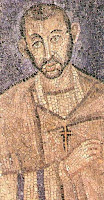There are three New Testament passages that are thought to be early hymns in honor of Jesus: Philippians 2:6-11, Colossians 1:15-20, and John 1:1-18. In their imagery, depth, and vision of Jesus they are unmatched. In the
Philippian hymn and
Colossian hymn the cross is prominent, occurring at the center of the hymn in Philippians and at the climactic end of the second stanza in Colossians. Given the importance of the cross for the early Christians, this is not surprising. What is surprising is that when we read John 1:1-18 the cross is not mentioned at all. Why and what does this tell us about the significance of the cross for the believers in John’s community?
First of all, there are probably good reasons that the cross is not mentioned in the John 1:1-18. It was not that the cross was not important to John. These verses function as a prologue to the whole of John’s Gospel. As such, they set out the major themes that will follow and serve to invite the reader to read the rest of the Gospel with the perspective that the prologue outlines. It is not necessary that a prologue should summarize the details of the following narrative. Further, the cross figures prominently in John’s Gospel as a whole. The cross is not specifically mentioned in the prologue since the reader would encounter it soon enough.
Second, in John’s Gospel it is important to note that the cross is not a shameful defeat for Jesus but represents instead the moment of the glorification of Jesus. Immediately after Judas left to betray him, leading to his crucifixion, Jesus said:
"Now is the Son of Man glorified, and God is glorified in him.” (Jn 13:31)
Here he was echoing the language of Isaiah: “You are my servant, Israel, in whom I will be glorified” (Is 49:3). The whole sequence of events leading up to the cross, beginning with the betrayal by Judas, was the way in which God’s glory was revealed. I sometimes have the tendency to think that God’s glory is revealed in the resurrection of Jesus—and it certainly is. But for John, the entire passion of Jesus was the revelation of God’s glory—not only the resurrection.
Third, though the cross is not mentioned in the prologue, the larger theme of the rejection of Jesus by the world certainly is. The prologue sets up a clear contrast between those who did not receive him and those who did. One stanza reads:
He was in the world,
and the world was made through him,
yet the world did not know him.
He came to his own,
and his own people did not receive him.
But to all who did receive him,
who believed in his name,
he gave the right to become children of God. (Jn 1:10-12)
So John talks not specifically about the cross here, but about the idea that there are those who rejected Jesus. This larger theme of the rejection of Jesus includes the rejection of Jesus by the Jewish leaders and by Pilate, the Roman ruler who had him crucified. Another stanza talks about the darkness trying to extinguish the light of Jesus:
The light shines in the darkness, and the darkness has not overcome it. (Jn 1:5)
This is poetic and metaphorical, but the scope of this image is broad enough to include the notion that the cross, the attempt at snuffing out of the life of Jesus by the forces of darkness, was unable to quench the divine light. A third stanza may also refer to the crucifixion since, as we have seen, for John the cross is the “glorification” of Jesus:
And the Word became flesh and dwelt among us, and we have seen his glory (Jn 1:14)
The “Word” in John’s poetic prologue, is Jesus. What was this glory that John and his companions saw? For John, the glory of Jesus is not just the miracles, or the teaching, or the resurrection. The glory of Jesus mentioned here includes the cross.
So the prologue invites the reader of John’s Gospel to read the story that follows and to look for the glory of Jesus in each aspect of his life, and especially in the cross. In addition, when one reads about the rejection of Jesus, including the rejection of Jesus by Pilate, the Roman ruler, the reader knows that this is part of the divine pattern. The reader can find his or herself in the story as well, whether as one who rejects Jesus, or one who receives him and sees in the cross a revelation of the glory of God.
As hymns, these three poetic passages in John, Philippians, and Colossians give us a glimpse into some of the ways that the death of Jesus was remembered among the earliest Christians. His death on the cross was a source of divine reversals in Philippians, a source of reconciliation in Colossians, and a revelation of the glory of God in John. And there is much more that these passages have to teach us. In these hymnic passages we gain a glimpse of the mystery of the cross, a mystery that will always exceed our capacity to grasp its ultimate meaning, but a mystery for which we can humbly give thanks to God.









